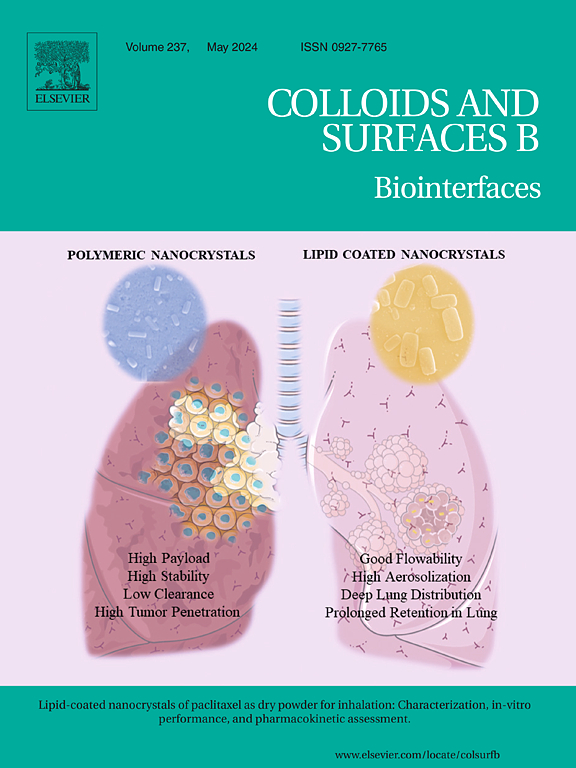葡萄糖氧化酶包埋的介孔聚多巴胺纳米颗粒产生CO,用于协同肿瘤饥饿,化学动力学和光热治疗
IF 5.4
2区 医学
Q1 BIOPHYSICS
引用次数: 0
摘要
饥饿疗法是利用葡萄糖氧化酶(Gox)将葡萄糖转化为葡萄糖酸和过氧化氢(H₂O₂)而开发的,代表了治疗严重依赖糖酵解途径来满足其高能量需求的肿瘤的有希望的方法。然而,Gox单药治疗的效果受到低氧肿瘤微环境和能量补偿机制激活的阻碍。在这项研究中,我们提出了一种新的多模式治疗纳米平台,可以协同整合饥饿治疗与光热治疗(PTT)和化学动力治疗(CDT),以克服这些局限性。介孔聚多巴胺(MPDA)是一种生物相容性材料,它与CO前体Fe₃(CO)₁₂和Gox结合在一起。到达肿瘤部位后,酸性环境激活纳米平台,启动葡萄糖通过Gox转化为葡萄糖酸和H₂O₂。这个过程促进了CO的释放和Fe 2 +的生成,导致一连串的芬顿反应产生活性氧(ROS)。CO抑制细胞色素c氧化酶,破坏线粒体三磷酸腺苷(ATP)的产生,下调热休克蛋白(Hsp),从而使肿瘤细胞对ptt诱导的损伤敏感。我们的研究结果表明,这种综合治疗方法显著提高了癌症治疗的疗效,为改善临床结果提供了一种有希望的策略。本文章由计算机程序翻译,如有差异,请以英文原文为准。
Glucose oxidase-embedded mesoporous polydopamine nanoparticles produce CO for synergistic tumor starvation, chemodynamic, and photothermal therapy
Starvation therapy, developed by exploiting glucose oxidase (Gox) to convert glucose into gluconic acid and hydrogen peroxide (H₂O₂), represents a promising approach to treating tumors that heavily rely on the glycolysis pathway to meet their high energy demands. However, the efficacy of Gox monotherapy is hindered by the hypoxic tumor microenvironment and activation of energy compensation mechanisms. In this study, we present a novel multimodal therapeutic nanoplatform that synergistically integrates starvation therapy with photothermal therapy (PTT) and chemodynamic therapy (CDT) to overcome these limitations. Mesoporous polydopamine (MPDA), a biocompatible material, was combined with the CO precursor Fe₃(CO)₁₂ and Gox. Upon reaching the tumor site, the acidic environment activates the nanoplatform, initiating the conversion of glucose to gluconic acid and H₂O₂ by Gox. This process facilitates CO release and Fe²⁺ generation, leading to a cascade of Fenton reactions that produce reactive oxygen species (ROS). CO inhibits cytochrome c oxidase, disrupting mitochondrial adenosine triphosphate (ATP) production and downregulating heat shock proteins (Hsp), thereby sensitizing tumor cells to PTT-induced damage. Our results demonstrate that this comprehensive therapeutic approach significantly enhances the efficacy of cancer treatment, offering a promising strategy for improved clinical outcomes.
求助全文
通过发布文献求助,成功后即可免费获取论文全文。
去求助
来源期刊

Colloids and Surfaces B: Biointerfaces
生物-材料科学:生物材料
CiteScore
11.10
自引率
3.40%
发文量
730
审稿时长
42 days
期刊介绍:
Colloids and Surfaces B: Biointerfaces is an international journal devoted to fundamental and applied research on colloid and interfacial phenomena in relation to systems of biological origin, having particular relevance to the medical, pharmaceutical, biotechnological, food and cosmetic fields.
Submissions that: (1) deal solely with biological phenomena and do not describe the physico-chemical or colloid-chemical background and/or mechanism of the phenomena, and (2) deal solely with colloid/interfacial phenomena and do not have appropriate biological content or relevance, are outside the scope of the journal and will not be considered for publication.
The journal publishes regular research papers, reviews, short communications and invited perspective articles, called BioInterface Perspectives. The BioInterface Perspective provide researchers the opportunity to review their own work, as well as provide insight into the work of others that inspired and influenced the author. Regular articles should have a maximum total length of 6,000 words. In addition, a (combined) maximum of 8 normal-sized figures and/or tables is allowed (so for instance 3 tables and 5 figures). For multiple-panel figures each set of two panels equates to one figure. Short communications should not exceed half of the above. It is required to give on the article cover page a short statistical summary of the article listing the total number of words and tables/figures.
 求助内容:
求助内容: 应助结果提醒方式:
应助结果提醒方式:


